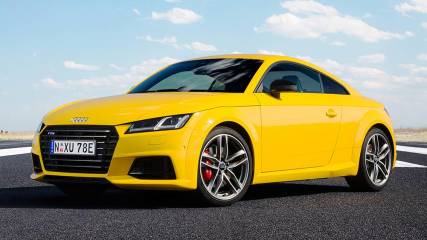Audi TTS Coupe 2016 review
By Peter Anderson · 31 Mar 2016
The Audi TT’s third generation range is starting to fill out. Less than a year from its debut on Australian roads, the warmed-up TTS arrived for those looking for a bit more oomph and dynamic ability from the iconic two door coupe.With a more powerful engine, amped-up looks inside and out and a focus on handling, the TTS also has quite the price tag.The TTS starts at a fairly stiff $99,900, a hefty $27,000 over the front-wheel drive base model and nearly ten grand more than the TT Quattro S-Line. For that you get bigger 19-inch alloy wheels, nine-speaker stereo with DAB, Bluetooth and USB, climate control, Alcantara and leather trim, front and rear parking sensors with reversing camera, keyless entry and start, adaptive damping, cruise control, Audi’s fully digital dashboard Virtual Cockpit, drive select, electric seats, satnav, automatic LED headlights, auto wipers, lane departure warning with steering assist and power windows.Our test car had metallic paint ($1400), optional twin spoke alloys ($350), matrix LED headlights ($1900), extended leather package ($1300), coloured interior elements ($470) and the $1900 Assistance Package. This package adds blind-spot monitoring, auto parking, high beam assist and heated folding exterior mirrors.This little lot brought the total to $108,620 before on-road costs.The new TT is as bold as the Bauhaus original first shown in 1995 at the Frankfurt Motor Show, before finally hitting the road in 1998. While the second-generation was a bit weak and got a bit lost trying to forge its own identity, the new TT is far more confident.The big flared wheel arches and arched, monoposto-style roof have stayed but everything else has been sharpened up. The Audi grille is low and wide, with slim, aggressive headlights housing Le Mans car-inspired daytime running lights.The TTS gets a beautifully integrated set of sill extensions and new bumpers front and rear. The rear incorporates a contrasting coloured diffuser flanked by four exhausts while the brake ducts up front look racier in a deeper bumper.Inside is standard TT, which is to say very pretty indeed. The interior of this car is a fantastic design although passengers may feel a bit left out without a central screen. When viewed from above, the dash is shaped like fighter plane wing. To carry on the theme, the air-con vents are circular with a turbine design. The centre hub houses the various controls for the climate control, clearing the console of a large number of buttons.Occupant space is good up front, with low seats ensuring decent headroom and there’s plenty of room for long legs in the front footwells. The rear seats are ridiculous. How anyone could ever get an ISOFIX seat in there is a mystery or cause for a referral to The Hague.Audi’s Virtual Cockpit is controlled by the MMI dial. The all-digital dashboard is a one stop shop for the usual speed, revs and warning messages as well as satnav, phone and stereo.The layout is slightly different to the standard car, too. The tachometer is front and centre, with a big digital speed readout in the middle. When you thumb the ‘view’ button on the steering wheel, the central dial splits into two smaller ones and move to the bottom corners of the dash to clear space for the other functions. It’s clear and at 60 frames per second, smooth as can be.The nine speaker stereo is more than enough to fill the small cabin. Controlled via the larger version of the MMI dial, it’s all contained within the car’s only screen in the dashboard. The TT has USB and Bluetooth connectivity as well as the option of Audi Connect for creating the car’s own internet hotspot.The satnav is an up-spec version with live traffic updates to help you navigate around snarls. If you’ve got internet in the car, you can also get a Google Maps overlay to show you the terrain.The new Quattro system is able to direct power up to 100% rearward which is, needless to say, most welcome for the keen driver.Audi Sport’s engineers had a very decent platform to start with on the basic TT. Much of the basics are carried over but with a far tauter base, to which is added sports adaptive damping.This gives the TTS an even more willing attitude when it comes to changing direction and, surprisingly, a pretty lively rear end. The problems of the base car remain in that the suspension doesn’t have much travel and a big bump will see the car bounce off the stops (and make a frightening, if harmless, noise while doing it). As if to make up for it, the car still sticks to your line unless the bump is absolutely gigantic, in which case you probably shouldn’t have driven over it.Tyre noise is a bit higher in the TTS, the 19-inch wheels wrapped in sticky 245/35 rubber (the standard car has 40 section tyres on 18-inch wheels) and the ride is a little more fidgety, and that’s before you switch to dynamic mode. Then things get serious.The throttle perks up even more, the damping stiffens up and – for a bit of theatre – the exhausts open up and start to bark and spit as you zoom from corner to corner. The steering’s weight also makes you feel more connected to the road – you probably wouldn’t want it this heavy full-time – making the act of driving more physical and more involving.The brakes on the TTS are spectacular, with a good, solid feel underfoot and an impressive line in not activating the ABS unless you really stand on them or the road surface is a bit of a mess.
.jpg)
.jpg)
.jpg)
.jpg)

.jpg)
.jpg)
.jpg)

.jpg)